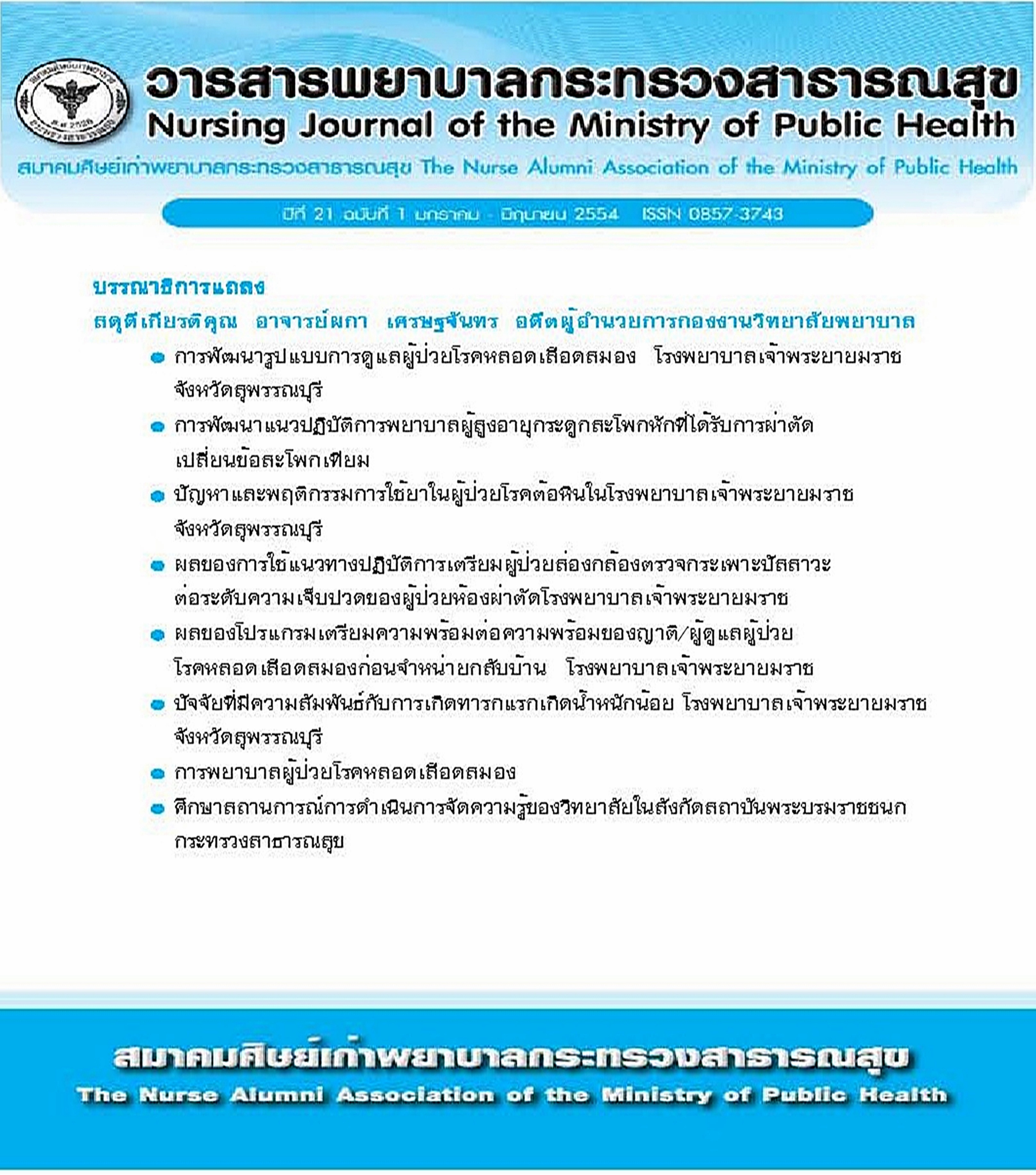ปัญหาและพฤติกรรมการใช้ยาในผู้ป่วยโรคต้อหินในโรงพยาบาลเจ้าพระยายมราช จังหวัดสุพรรณบุรี
Main Article Content
Abstract
ปัญหาและพฤติกรรมการใช้ยาในผู้ป่วยโรคต้อหินในโรงพยาบาลเจ้าพระยายมราช
จังหวัดสุพรรณบุรี
บทคัดย่อ
การวิจัยนี้มีวัตถุประสงค์เพื่อศึกษาปัญหาสาเหตุและอาการไม่พึงประสงค์จากการใช้ยา การดูแลตนเอง ความต้องการการสนับสนุนจากผู้ดูแลและศึกษาพฤติกรรมการใช้ยาหยอดตาของผู้ป่วยต้อหิน กลุ่มตัวอย่าง คือผู้ป่วยต้อหินที่ได้รับการรักษาโดยการใช้ยาและมารับการรักษาที่แผนกจักษุผู้ป่วยนอกโรงพยาบาลเจ้าพระยายมราช จังหวัดสุพรรณบุรี จำนวน 200 คน เครื่องมือที่ใช้ในการวิจัยเป็นแบบสัมภาษณ์ปัญหาการใช้ยา ประกอบด้วยแบบสัมภาษณ์ข้อมูลส่วนบุคคล การดูแลตนเองและความต้องการการสนับสนุนจากผู้ดูแลพฤติกรรมการหยอดตาและการใช้ยาหยอดตาและปัญหาที่พบจากการใช้ยา วิเคราะห์ข้อมูลโดยแจกแจงความถี่และหาค่าร้อยละ ผลการศึกษาพบผู้ป่วยต้อหินมีความดันลูกตาสูงมากกว่า 21 มิลิเมตรปรอทในตาข้างขวา ร้อยละ 14.5 และข้างซ้ายร้อยละ 9 มีปัญหาความบกพร่องทางกายร้อยละ 22.5 ต้องการผู้ดูแลร้อยละ 19 ความต้องการให้ผู้ดูแลพาไปพบแพทย์ร้อยละ 27.5 และช่วยหยอดตาร้อยละ 7 พบปัญหาจากการใช้ยาหยอดตา อันดับ 1 ได้แก่ ใช้ยาหยอดตาขวดเก่าเกินกว่า 1 เดือนร้อยละ 54 ส่วนใหญ่ไม่ทราบผลเสียของการไม่หยอดตาร้อยละ 84 ไม่ได้รับเอกสารการหยอดตาร้อยละ 60 อันดับ 2 ใช้ยาผิดวิธีร้อยละ 41.5 อันดับ 3 ลืมหยอดตาร้อยละ 37 พบว่าเช้าก่อนมาโรงพยาบาลผู้ป่วยต้อหินไม่หยอดตาร้อยละ 31.5 การแก้ปัญหาเมื่อลืมหยอดตาผู้ป่วยรอไปหยอดครั้งต่อไปร้อยละ 30.1 อันดับ 4 ยาหยอดตาหมดก่อนวันนัดร้อยละ 15 การแก้ปัญหาเมื่อยาหมดคือไม่ได้หยอดรอจนถึงวันนัดร้อยละ 71.7 อันดับ 5 อาการไม่พึงประสงค์จากการใช้ยาร้อยละ 9 การปฏิบัติตามขั้นตอนการหยอดตาพบว่าหยอดตาไม่ถูกต้องร้อยละ 48
การติดตามปัญหาการใช้ยาและพฤติกรรมการใช้ยา ทำให้ปัญหาการใช้ยาในผู้ป่วยต้อหินลดลง โดยเพิ่มความร่วมมือในการใช้ยาลดอาการไม่พึงประสงค์จากยา การเพิ่มคำแนะนำให้ความรู้เรื่องโรค การใช้ยาวิธีหยอดตา การบริหารยาให้สอดคล้องกับผู้ป่วย การสร้างระบบช่วยในการจำจะทำให้การรักษาได้ผล
มีประสิทธิภาพ
* พยาบาลวิชาชีพ โรงพยาบาลเจ้าพระยายมราช จังหวัดสุพรรณบุรี
Medical problems and medication use behaviors in glaucoma in glaucoma patients at Chaophayayomaraj Hospital in Suphanburi Province, Thailand.
Abstract
The purpose of this study was to explore the medical problems and medication use behaviors in glaucoma patients at Choapraya Yommaraj hospital in Suphanburi Province. Method: Subjects comprised 200 randomly selected glaucoma patients visiting the hospital’s out-patient department. An instrument used in this survey interview was divided into four sections. These sections included patient characteristics, self care and patient support practices, medication use, and side effects and other problems associated with medication use. The data were compiled and tabulated using SPSS. Result: The result show that 14.5, 9 % of patient had intraoccular pressure (IOP) higher than 21 mmhg in the right and the left eye. Five patients (19%) suffered disabilities of which nearly all required assistance from a
doctor’s visit (27.5%) and the application of medication (7%). Compliance continues to be a barrier to effective glaucoma care. Forgetfulness is the leading cause of non-compliance. Five medication problems behaviors are: continuing to use the same bottle of eye drop for longer than 30 days (54%) suggesting that
significant numbers of patients are at risk of contaminating the eye drop ,The majority of patients (84%) are not aware of adverse consequences for failing to apply eye drops. Three – fifth (60%) of the patients reported having received no instructional documentation on how to property administer the eye drops. Improper administration techniques (41.5%), forgetfulness (37%). Nearly one-third (31.5%) of the patients
failed to apply medication on the morning of the physician’s visits. Among those who forgot to apply eye drop daily, about one – third (30.1%) skipped to the next scheduled application. Another problem was failing to get medication refilled when the eye drops ran out before the scheduled doctor’s appointment
(15%). When the medication ran out seven in ten (71.7%) skipped applying eye drops until after the next Physician’s visit. Less than one in ten (9%) patients reported to have adverse drug reaction from the medications. It was found that there are significant variations in the eye drop administration techniques.
Nearly half (48%) fail to apply eye drops properly. Interpretation: Nearly one–third of the patients surveyed were either non-compliant or exhibited improper administration techniques. Conclusion: The medical treatment of glaucoma primarily relies on topical ocular medication. Non-compliance with the prescribed
treatment remains to a significant obstacle to effective treatment of glaucoma. Evidence clearly suggests that the non–compliance remains prevalent. The study highlights the need to better educate patients about the disease, importance of compliance and better demonstrations of the proper administration of
the eye drops. Such programs can potentially improve the efficacy of the therapy and help reduce adverse drug reactions from the improper use of the medications.
Keywords : Medical problem / medication use behavior / glaucoma patients
* Registered Nurse : Choapraya Yommaraj Hospital
Article Details
บทความและรายงานวิจัยในวารสารพยาบาลกระทรวงสาธารณสุข เป็นความคิดเห็นของ ผู้เขียน มิใช่ของคณะผู้จัดทำ และมิใช่ความรับผิดชอบของสมาคมศิษย์เก่าพยาบาลกระทรวงสาธารณสุข ซึ่งสามารถนำไปอ้างอิงได้

